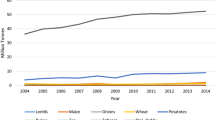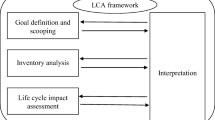Abstract
This study was conducted to assess the impact of cereals (wheat and barley) production on environment under rainfed and irrigated farming systems in northeast of Iran. Life cycle assessment (LCA) was used as a methodology to assess all environmental impacts of cereal grain production through accounting and appraising the resource consumption and emissions. The functional unit considered in this study was one ton grain yield production under different rates of nitrogen application. All associated impacts of different range of N fertilizer application were evaluated on the basis of the functional unit. In this study, three major impact categories considered were climate change, acidification, and eutrophication. In order to prepare final evaluation of all impacts on environment, the EcoX was determined. Results represented that, under low consumption of N fertilizer, the environmental impacts of both rainfed farming systems of wheat and barley was less than irrigated farming systems. Considering grain yield as response factor to different fertilizer application level, irrigated farming systems of wheat and barley with the range of 160–180 and >220 (Kg N ha−1) showed the maximum impact on environment. It seems LCA is an appropriate method to quantify the impact of utilized agricultural inputs and different managements on environment.







Similar content being viewed by others
References
Anonymous. (2008). High-level conference on world food security, climate change adaptation and mitigation: Challenges and opportunities for food security. 3–5 June: Rome.
Anonymous. (2009). Results of a survey of wheat and barley crop production in Iran (pp. 2–16). Tehran, Iran: Ministry of Agriculture, The office of Statical Information Reports and Publications.
Bannayan, M., Lakzian, A., Gorbanzadeh, N., & Roshani, A. (2011a). Variability of growing season indices in northeast of Iran. Theoretical Applied Climatology, 105, 485–494.
Bannayan, M., Lotfabadi, S., Sanjani, S., Mohammadian, A., & Agaalikhani, M. (2011b). Effects of precipitation and temperature on cereal yield variability in northeast of Iran. International Journal of Biometeorology, 55, 387–401.
Bannayan, M., & Sanjani, S. (2011). Weather conditions associated with irrigated crops in an arid and semi arid environment. Agricultural Forest Meteorology, 151, 1589–1598.
Bannayan, M., Sanjani, S., Alizadeh, A., Lotfabadi, S., & Mohammadian, A. (2010). Association between climate indices aridity index, and rainfed crop yield in northeast of Iran. Field Crops Research, 118(2), 105–114.
Barker-Reid, F., Gates, W. P., Wilson, K., Baigent, R., Galbally, I. E., Meyer, C. P., et al. (2005). Soil nitrous oxide emission from rainfed wheat in SE Australia. In A. van Amsted (ed). Non-CO 2 greenhouse gases (NCGG-4). Utrecht, the Netherlands: Millpress.
Basset-Mens, C., Anibar, L., Durand, P., & Werf, H. M. G. (2006). Spatialised fate factors for nitrate in catchments: Modelling approach and implication for LCA results. Science of the Total Environment, 367, 367–382.
Biswas, W. K., Barton, L., & Carter, D. (2008). Global warming potential of wheat production in Western Australia: A life cycle assessment. Water and Environment Journal, 22, 206–216.
Bouwman, A. F. (1990). Exchange of greenhouse gases between terrestrial ecosystems and the atmosphere. In A. F. Bouwman (Ed.), Soils and the greenhouse effect (pp. 61–127). Chichester: Wiley.
Braschkat, J., Braschkat, A., Quirin, M., Reinhardt, G. A. (2003). Life cycle assessment of bread production—a comparison of eight different scenarios. Life cycle assessment in the agric-food sector. In Proceedings from the 4th International Conference, 6–8 October, Denmark.
Brentrup, F., Küsters, J., Kuhlmann, H., & Lammel, J. (2001). Application of the life cycle assessment methodology to agricultural production: An example of sugar beet production with different forms of nitrogen fertilisers. European Journal of Agronomy, 14, 221–233.
Brentrup, F., Kusters, J., Kulmann, H., & Lamme, J. (2004a). Environmental impact assessment of agricultural production systems using the life cycle assessment methodology: I. Theoretical concept of a LCA method tailored to crop production. European Journal of Agronomy, 20(3), 246–247.
Brentrup, F., Kusters, J., Lamme, J., Barraclough, P., & Kulmann, H. (2004b). Environmental impact assessment of agricultural production systems using the life cycle assessment (LCA) methodology: II. The application to N fertilizer use in winter wheat production systems. European Journal of Agronomy, 20(3), 265–279.
Brentrup, F., Küsters, J., Lammel, J., & Kuhlmann, H. (2002a). Impact assessment of abiotic resources consumption—conceptual considerations. International Journal of LCA, 7, 301–307.
Brentrup, F., Küsters, J., Lammel, J., & Kuhlmann, H. (2002b). Life cycle impact assessment of land use based on the Hemeroby concept. International Journal of LCA, 7, 339–348.
Consoli, F., Allen, D., Boustead, I., Fava, J., Franklin, W., Jensen, A. A., et al. (1993). Guidelines for life-cycle assessment: A ‘code of practice’. Brussels: Society of Environmental Toxicology and Chemistry (SETAC).
Crutzen, P. J. (1981). Atmospheric chemical processes of the oxides of nitrogen, including nitrous oxide. In C. C. Delwiche (Ed.), Denitrification, nitrification, and atmospheric nitrous oxide (pp. 17–44). New York: Wiley.
Dentener, F., Derwent, R., Dlugokencky, E., Holland, E., Isaksen, I., Katima, J., et al. (2001). Atmospheric chemistry and greenhouse gases. In Houghton, J. T., Ding, Y., Griggs, D. J., et al. (eds). Climate change 2001: The scientific basis. Contributions of Working Group 1 to the assessment report of the Intergovernmental Panel on climate change Cambridge University Press, Cambridge, UK and New York, NY, USA.
Ekvall, T., & Finnveden, G. (2001). Allocation in ISO 14041—a critical review. Cleaner Prod., 9, 197–208.
Finkbeiner, M., Inaba, A., Tan, R. B. H., Christiansen, K., & Klüppel, H. J. (2006). The new international standards for life cycle assessment: ISO 14040 and ISO 14044. International Journal of Life Cycle Assessment, 11(2), 80–85.
Goedkoop, M. (1995). NOH report 9523. The eco-indicator 95. Final Report. Amersfoort: Pré Consultants.
Goedkoop, M., Spriensma, R. (1999). The eco-indicator 99. A damage oriented method of life cycle impact assessment. Methodology Report. Amersfoort: Pré Consultants.
Guinée, J. B., Gorrée, M., Heijungs, R., Huppes, G., Kleijn, R., & de Koning, A. (2002). Handbook on life cycle assessment: An operational guide to the ISO standards. Leiden: Centre of Environmental Science, Leiden University.
Haas, G., Wetterich, F., & Kopke, U. (2001). Comparing intensive, extensified and organic grassland farming in southern Germany by process life cycle assessment. Agriculture, Ecosystems & Environment, 83, 43–53.
Harrison, P., & Pearce, F. (2000). AAAS atlas of population and environment. Berkeley, USA: University of California Press.
Hayashi, K. (2005). Practical implications of functional units in life cycle assessment for horticulture: Intensiveness and environmental impacts (vol. 1, pp. 368–371). LCM2005: Innovation by Life Cycle Management: Barcelona, Spain.
Heijungs, R. (1992). Environmental life cycle assessment of products. Guide—October 1992 (pp. 28–32). Leiden: Centre of Environmental Science, Leiden University.
Heijungs, R., Guinée, J. B., & Huppes, G. (1997). Impact categories for natural resources and land use. CML report 138. Section Substances and Products. Centre of Environmental Science (CML), Leiden University: Leiden.
Hospido, A., Moreira, M. T., & Feijoo, G. (2003). Simplified life cycle assessment of Galician milk production. International Dairy Journal, 13(10), 783–796.
Houghton, J. T., Ding, Y., Griggs, D. J., Noguer, M., Linden, P. J., Dai, X., et al. (2001). Climate change 2001: The scientific basis. Contributions of Working Group 1 to the Assessment report of the Intergovernmental Panel on climate change, Cambridge University Press, Cambridge.
Ichir, L. L., Ismaili, M., & Van Cleemput, O. (2003). Effect of organic and mineral fertilizers on N-use by wheat under different irrigation frequencies. Comptes Rendus Biologies, 326, 391–399.
Iriarte, A., Rieradevall, J., & Gabarrell, X. (2010). Life cycle assessment of sunflower and rapeseed as energy crops under Chilean conditions. Cleaner Production, 18, 336–345.
ISO. (1997). International standard 14040. Environmental management—life cycle assessment—principles and framework. Geneva, Switzerland: International Organisation for Standardisation (ISO).
ISO. (2006). ISO 14040: 2006 (E) environmental management—life cycle assessment—principles and framework.
Karimzadegan, H., Gilanpour, A., & Mirhosseyni, S. (2006). Effects of subsidiary fertilizer on unoptimized consumption of wheat crop (Tritichum aestivum). Agricultural Economy, 55, 121–133.
Küsters, J., & Jenssen, T. (1998). Selecting the right fertilizer from an environmental life cycle perspective. In: IFA (International Fertilizer Industry Association) (Ed.), 1998 IFA technical conference Marrakech, Morocco (pp. 290–296).
Lehuger, S., Gabrielle, B., & Gagnaire, N. (2009). Environmental impact of the substitution of imported soybean meal with locally-produced rapeseed meal in dairy cow feed. Cleaner Production, 17, 616–624.
Meisterling, K., Samaras, C., & Schweizer, V. (2009). Decisions to reduce greenhouse gases from agriculture and product transport: LCA case study of organic and conventional wheat. Cleaner Production, 17, 222–230.
Payraudeau, S., & van der Werf, H. M. G. (2005). Environmental impact assessment for a farming region: A review of methods. Agriculture, Ecosystems & Environment, 107, 1–19.
Robertson, G. P., Paul, E. A., & Harwood, R. R. (2000). Greenhouse gases in intensive agriculture: Contributions of individual gases to the radiative forcing of the atmosphere. Science, 289, 1922–1925.
Roy, P., Nei, D., Orikass, T., Xu, Q., Okadome, H., Nakamura, N., et al. (2009). A review of life cycle assessment (LCA) on some food productions. Food Engineering, 91, 1–10.
Sheehan, J., Camobreco, V., Duffield, J., Graboski, M., & Shapouri, H. (1998). Life cycle inventory of biodiesel and petroleum diesel for use in an urban bus. Colorado: NREL/SR-580–24089 UC Category 1503, National Renewable Energy Laboratory.
Author information
Authors and Affiliations
Corresponding author
Rights and permissions
About this article
Cite this article
Fallahpour, F., Aminghafouri, A., Ghalegolab Behbahani, A. et al. The environmental impact assessment of wheat and barley production by using life cycle assessment (LCA) methodology. Environ Dev Sustain 14, 979–992 (2012). https://doi.org/10.1007/s10668-012-9367-3
Received:
Accepted:
Published:
Issue Date:
DOI: https://doi.org/10.1007/s10668-012-9367-3




